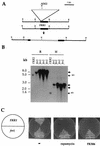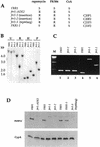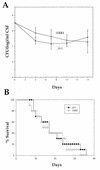Rapamycin antifungal action is mediated via conserved complexes with FKBP12 and TOR kinase homologs in Cryptococcus neoformans
- PMID: 10330150
- PMCID: PMC104369
- DOI: 10.1128/MCB.19.6.4101
Rapamycin antifungal action is mediated via conserved complexes with FKBP12 and TOR kinase homologs in Cryptococcus neoformans
Abstract
Cryptococcus neoformans is a fungal pathogen that causes meningitis in patients immunocompromised by AIDS, chemotherapy, organ transplantation, or high-dose steroids. Current antifungal drug therapies are limited and suffer from toxic side effects and drug resistance. Here, we defined the targets and mechanisms of antifungal action of the immunosuppressant rapamycin in C. neoformans. In the yeast Saccharomyces cerevisiae and in T cells, rapamycin forms complexes with the FKBP12 prolyl isomerase that block cell cycle progression by inhibiting the TOR kinases. We identified the gene encoding a C. neoformans TOR1 homolog. Using a novel two-hybrid screen for rapamycin-dependent TOR-binding proteins, we identified the C. neoformans FKBP12 homolog, encoded by the FRR1 gene. Disruption of the FKBP12 gene conferred rapamycin and FK506 resistance but had no effect on growth, differentiation, or virulence of C. neoformans. Two spontaneous mutations that confer rapamycin resistance alter conserved residues on TOR1 or FKBP12 that are required for FKBP12-rapamycin-TOR1 interactions or FKBP12 stability. Two other spontaneous mutations result from insertion of novel DNA sequences into the FKBP12 gene. Our observations reveal that the antifungal activities of rapamycin and FK506 are mediated via FKBP12 and TOR homologs and that a high proportion of spontaneous mutants in C. neoformans result from insertion of novel DNA sequences, and they suggest that nonimmunosuppressive rapamycin analogs have potential as antifungal agents.
Figures







Similar articles
-
Rapamycin and less immunosuppressive analogs are toxic to Candida albicans and Cryptococcus neoformans via FKBP12-dependent inhibition of TOR.Antimicrob Agents Chemother. 2001 Nov;45(11):3162-70. doi: 10.1128/AAC.45.11.3162-3170.2001. Antimicrob Agents Chemother. 2001. PMID: 11600372 Free PMC article.
-
Rapamycin exerts antifungal activity in vitro and in vivo against Mucor circinelloides via FKBP12-dependent inhibition of Tor.Eukaryot Cell. 2012 Mar;11(3):270-81. doi: 10.1128/EC.05284-11. Epub 2011 Dec 30. Eukaryot Cell. 2012. PMID: 22210828 Free PMC article.
-
Secretion of FK506/FK520 and rapamycin by Streptomyces inhibits the growth of competing Saccharomyces cerevisiae and Cryptococcus neoformans.Microbiology (Reading). 1999 Aug;145 ( Pt 8):1989-2000. doi: 10.1099/13500872-145-8-1989. Microbiology (Reading). 1999. PMID: 10463165
-
TOR kinase homologs function in a signal transduction pathway that is conserved from yeast to mammals.Mol Cell Endocrinol. 1999 Sep 10;155(1-2):135-42. doi: 10.1016/s0303-7207(99)00121-5. Mol Cell Endocrinol. 1999. PMID: 10580846 Review.
-
Elucidating TOR signaling and rapamycin action: lessons from Saccharomyces cerevisiae.Microbiol Mol Biol Rev. 2002 Dec;66(4):579-91, table of contents. doi: 10.1128/MMBR.66.4.579-591.2002. Microbiol Mol Biol Rev. 2002. PMID: 12456783 Free PMC article. Review.
Cited by
-
Expression of mTOR in normal and pathological conditions.Mol Cancer. 2023 Jul 15;22(1):112. doi: 10.1186/s12943-023-01820-z. Mol Cancer. 2023. PMID: 37454139 Free PMC article. Review.
-
When synthetic biology meets medicine.Life Med. 2024 Mar 6;3(1):lnae010. doi: 10.1093/lifemedi/lnae010. eCollection 2024 Feb. Life Med. 2024. PMID: 39872399 Free PMC article. Review.
-
Non-dikarya fungi share the TORC1 pathway with animals, not with Saccharomyces cerevisiae.Sci Rep. 2025 Feb 18;15(1):5926. doi: 10.1038/s41598-025-89635-4. Sci Rep. 2025. PMID: 39966606 Free PMC article.
-
An overview of rapamycin: from discovery to future perspectives.J Ind Microbiol Biotechnol. 2017 May;44(4-5):537-553. doi: 10.1007/s10295-016-1834-7. Epub 2016 Sep 9. J Ind Microbiol Biotechnol. 2017. PMID: 27613310 Review.
-
Synergistic antifungal activities of bafilomycin A(1), fluconazole, and the pneumocandin MK-0991/caspofungin acetate (L-743,873) with calcineurin inhibitors FK506 and L-685,818 against Cryptococcus neoformans.Antimicrob Agents Chemother. 2000 Mar;44(3):739-46. doi: 10.1128/AAC.44.3.739-746.2000. Antimicrob Agents Chemother. 2000. PMID: 10681348 Free PMC article.
References
-
- Alarcon C M, Cardenas M E, Heitman J. Mammalian RAFT1 kinase domain provides rapamycin-sensitive TOR function in yeast. Genes Dev. 1996;10:279–288. - PubMed
Publication types
MeSH terms
Substances
Associated data
- Actions
- Actions
- Actions
- Actions
Grants and funding
LinkOut - more resources
Full Text Sources
Other Literature Sources
Molecular Biology Databases
